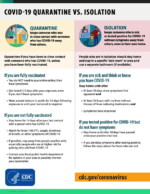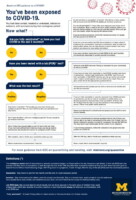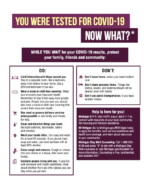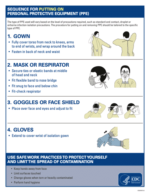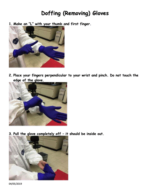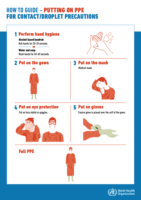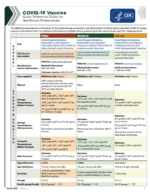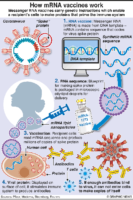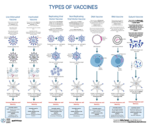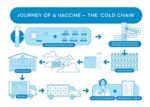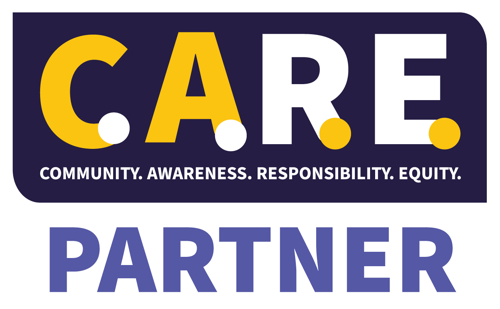The hospital and mortality burden of COVID-19 compared with influenza in Denmark: a national observational cohort study, 2022–24 (NEW 2/10, Website, Publication)The Lancet - Infectious Diseases
29 January 2025
P Bager, et al.
An observational study comparing the severity of COVID-19 and influenza among nearly 6 million Denmark residents finds a higher rate of hospitalizations and deaths in those infected with SARS-CoV-2—mainly among unvaccinated people, those with chronic conditions, and males—from 2022 to 2024.
Bat species assemblage predicts coronavirus prevalence (Document, Publication)Nature Communications
19 May 2023
Meyer M, Melville DW, Baldwin HJ, et al.
In line with the One Health framework, our work supports the notion that biodiversity conservation may be the most proactive measure to prevent the spread of pathogens with zoonotic potential.
SARS-CoV-2 Rebound With and Without Use of COVID-19 Oral Antivirals (Website)CDC/MMWR
22 December 2023
Smith DJ, Lambrou A, Patel P
After anti-viral treatment, no consistent association between treatment and rebound was identified.
Remission of severe forms of long COVID following monoclonal antibody (MCA) infusions: A report of signal index cases and call for targeted research (Website)ScienceDirect
4 October 2023
Scheppke KA, Pepe PE, et al.
Three individuals with long Covid experienced full remission within a week after monoclonal antibody infusion.
Omicron COVID-19 Case Estimates Based on Previous SARS-CoV-2 Wastewater Load, Regional Municipality of Peel, Ontario, Canada (Website, Publication)CDC / Emerging Infectious Diseases
28 June 2023
Cheng L, Dhiyebi H, Varia M, Atanas K, Srikanthan N, Hayat S, et al..
At the peak of the Omicron BA.2 outbreak in April 2022, reported COVID-19 cases were underestimated 19-fold because of changes in clinical testing.
Interim Recommendations for Use of Bivalent mRNA COVID-19 Vaccines for Persons Aged ≥6 Months — United States, April 2023 (Website, Publication)CDC/MMWR
16 June 2023
Moulia DL, Wallace M, Roper LE, et al.
Updated vaccine recommendations for children > 6 months and adults >65.
COVID-19 Surveillance After Expiration of the Public Health Emergency Declaration ― United States, May 11, 2023CDC/MMWR
12 May 2023
Silk BJ, Scobie HM, Duck WM, et al.
The authors indicate the following: “Changes to the national COVID-19 monitoring strategy and COVID Data Tracker capitalize on marked improvements in multiple surveillance systems.”
Persistent prosopagnosia following COVID-19Science Direct
1 May 2023
Kieseler ML, Duchaine B
Long covid effects may include the inability to recgonize faces.
Ventilation Improvements Among K–12 Public School Districts — United States, August–December 2022CDC/MMWR
7 April 2023
Mark-Carew M, Kang G, Pampati S, Mead KR, Martin SB Jr., Barrios LC
To reduce school transmission of SARS-CoV-2, K–12 public school districts implemented various types of ventilation improvements.
Accelerated Longitudinal Weight Gain Among Infants With In Utero COVID-19 Exposure (Website, Publication)Journal of Clinical Endocrinology and Metabolism (JCEM)
29 March 2023
Mollie WO, et al.
Infants with in utero COVID-19 exposure vs controls exhibited differential trajectories of weight and BMI.
Notes from the Field: Aircraft Wastewater Surveillance for Early Detection of SARS-CoV-2 Variants — John F. Kennedy International Airport, New York City, August–September 2022 (Website, Publication)CDC/MMWR
24 February 2023
Morfino RC, Bart SM, Franklin A, et al.
Summary from publication: During August 1–September 9, 2022, the biotech company Ginkgo Bioworks, in collaboration with CDC, evaluated the feasibility of SARS-CoV-2 variant detection in aircraft wastewater from incoming international flights.
Association of COVID-19 Vaccination With Risk for Incident Diabetes After COVID-19 Infection (Website)JAMA Open Network
14 February 2023
Kwan, A., et.al
Diabetes risk after COVID-19 infection was higher in unvaccinated than vaccinated patients, suggesting a benefit of vaccination.
Viral burden rebound in hospitalised patients with COVID-19 receiving oral antivirals in Hong Kong: a population-wide retrospective cohort study (Website)The Lancet: Infectious Diseases
13 February 2023
The Lancet: Viral burden rebound in hospitalised patients with COVID-19 receiving oral antivirals in Hong Kong: a population-wide retrospective cohort study. Wong, C., et.al. (Feb 13, 2023)
Wong, C., et.al.
Viral burden rebound rates are similar between patients with antiviral treatment and those without. Importantly, viral burden rebound was not associated with adverse clinical outcomes.
Early Treatment with Pegylated Interferon Lambda for Covid-19 (Website)The New England Journal of Medicine (NEJM)
9 February 2023
Reis G, et.al.
Among predominantly vaccinated outpatients with Covid-19, the incidence of hospitalization or an emergency department visit was significantly lower among those who received a single dose of pegylated interferon lambda than among those who received placebo.
COVID-19 Mortality and Progress Toward Vaccinating Older Adults — World Health Organization, Worldwide, 2020–2022 (Website, Regulatory)CDC/MMWR
3 February 2023
Wong MK, Brooks DJ, Ikejezie J, et al.
COVID-19–associated mortality among persons aged ≥60 years exceeded 80% of total COVID-19 mortality in 2020 and 2021 across all income groups.
Features, Evaluation, and Treatment of Coronavirus (COVID-19) (Website, Publication)NIH: StatPearl Publishing
9 January 2023
Cascella M, Rajnik M, Aleem A, et al.
The authors say: “This review article aims to comprehensively describe the etiology, epidemiology, pathophysiology, clinical features, diagnostic methods, and the latest novel therapeutics in the management of COVID-19.”
Safety Monitoring of Bivalent COVID-19 mRNA Vaccine Booster Doses Among Persons Aged ≥12 Years — United States, August 31–October 23, 2022 (Website, Regulatory)CDC/MMWR
4 November 2022
Hause AM, Marquez P, Zhang B, et al.
Early safety findings from v-safe and the Vaccine Adverse Event Reporting System for bivalent booster doses administered to persons aged ≥12 years during the first 7 weeks of vaccine availability are similar to those previously described for monovalent vaccine booster vaccines.
SARS-CoV-2 infection drives an inflammatory response in human adipose tissue through infection of adipocytes and macrophages (Website, Publication)Science: Translational Medicine
22 September 2022
Martínez-Colón GJ, Ratnasiri K, et al.
Authors state that the data suggest that SARS-CoV-2 infection of adipose tissue could contribute to COVID-19 severity through replication of virus within adipocytes and through induction of local and systemic inflammation driven by infection of adipose tissue-resident macrophages.
Association between BNT162b2 vaccination and reported incidence of post-COVID-19 symptoms: cross-sectional study 2020-21 (Website, Publication)Nature: NPJ Vaccines
17 January 2022
Kuodi, P., Gorelik, Y., Zayyad, H. et al.
Vaccination with at least two doses of COVID-19 vaccine was associated with a substantial decrease in reporting the most common post-acute COVID-19 symptoms, bringing it back to baseline. Our results suggest that, in addition to reducing the risk of acute illness, COVID-19 vaccination may have a protective effect against long COVID.
The virucidal effects of 405 nm visible light on SARS-CoV-2 and influenza A virus (Website, Publication)Nature – Scientific Reports
Rathnasinghe R, Jangra S, Miorin L, et al.
SARS-CoV-2 Omicron is an immune escape variant with an altered cell entry pathway (Website, Publication)Nature Microbiology
7 July 2022
Willett BJ, Grove J, MacLean OA et al.
This study shows evasion of neutralization by Omicron BA.1 and BA.2 variants in vitro using sera from individuals vaccinated with ChAdOx1, BNT162b2 and mRNA-1273.
Bloodborne Viral Pathogen Contamination in the Era of Laboratory AutomationAACC, Clinical Chemistry
1 July 2022
Bryan A., et.al
An interesting reference for testing for SARS-CoV-2 and others — A low level of viral contamination of automated clinical laboratory equipment occurs in clinical use. Given the risks associated with highly infectious agents, there is a need for risk-mitigation procedures when handling all samples.
Reported exposures among in-person workers with SARS-CoV-2 infection in 6 states, September 1 2020–June 2021 (Website, Publication)NIH: Clinical Infectious Diseases
19 June 2022
Free H, Luckhaupt SE, et al.
Workers in protective service occupations (48.8%) and public administration industries (35.6%) reported exposure at work most often
Neurodevelopmental Outcomes at 1 Year in Infants of Mothers Who Tested Positive for SARS-CoV-2 During PregnancyJAMA Network
9 June 2022
Edlow A, et. al
Preliminary findings suggest that COVID-19 exposure may be associated with neurodevelopmental changes and highlight the need for prospective investigation of outcomes in children exposed to COVID-19 in utero.
Aerosol particle emission increases exponentially above moderate exercise intensity resulting in superemission during maximal exercise (NEW 6/2, Website, Publication)Proceedings of the National Academy of Sciences of the USA
23 May 2022
Mutsch B, Heiber M, Grätz F, Hain R, Schönfelder M, Kaps S, Schranner D, Kähler CJ, Wackerhage H
Incidence of Guillain-Barré Syndrome After COVID-19 Vaccination in the Vaccine Safety Datalink (Website, Publication)JAMA Network
26 April 2022
Incidence of Guillain-Barré Syndrome After COVID-19 Vaccination in the Vaccine Safety Datalink. JAMA Netw Open. 2022;5(4):e228879. doi:10.1001/jamanetworkopen.2022.8879
Hanson KE, Goddard K, Lewis N, et al.
Surveillance data from the Vaccine Safety Datalink showed increased incidence rate of confirmed GBS 1 to 21 days after receiving the Ad.26.COV2.S (Janssen).
Heat inactivation of clinical COVID-19 samples on an industrial scale for low risk and efficient high-throughput qRT-PCR diagnostic testing (Website, Publication)Scientific Reports
21 February 2022
Delpuech O, Douthwaite JA, Hill T, et al.
Heating as the sole method of virus inactivation is ideally suited to streamlined and more rapid workflows such as ‘direct to PCR’ assays that do not involve RNA extraction or chemical neutralisation methods.
Effectiveness of COVID-19 Pfizer-BioNTech BNT162b2 mRNA Vaccination in Preventing COVID-19–Associated Emergency Department and Urgent Care Encounters and Hospitalizations Among Nonimmunocompromised Children and Adolescents Aged 5–17 Years — VISION Network, 10 States, April 2021–January 2022 (Website, Publication)CDC/MMWR
18 December 2021
Klein NP, Stockwell MS, Demarco M, et al.
Two doses protect against COVID-19–associated emergency department and urgent care encounters among children and adolescents. However, vaccine effectiveness (VE) was lower during Omicron predominance and decreased with time since vaccination; a booster dose restored VE to 81% among adolescents aged 16–17 years. Overall, 2-dose VE against COVID-19–associated hospitalization was 73%–94%.
SARS-CoV-2 in the Air: What’s Known and What Isn’t (NEW 3/7, Website, Publication, News)The Scientist
18 February 2022
Evidence suggests that COVID-19 is primarily an airborne disease. Yet the details of how transmission occurs are still debated and frequently misunderstood.
Effectiveness of Maternal Vaccination with mRNA COVID-19 Vaccine During Pregnancy Against COVID-19–Associated Hospitalization in Infants Aged <6 Months — 17 States, July 2021–January 2022 (Website, Publication)CDC/MMWR
15 February 2022
Halasa NB, Olson SM, Staat MA, et al.
Completion of a 2-dose mRNA COVID-19 vaccination series during pregnancy might help prevent COVID-19 hospitalization among infants aged <6 months.
Emerging Vaccine-Breakthrough SARS-CoV-2 Variants (Website, Publication)ACS Infectious Diseases
8 February 2022
Wang R, et.al
SARS-CoV-2 Infection and Hospitalization Among Adults Aged ≥18 Years, by Vaccination Status, Before and During SARS-CoV-2 B.1.1.529 (Omicron) Variant Predominance — Los Angeles County, California, November 7, 2021–January 8, 2022 (Website, Publication)CDC
4 February 2022
Danza P, Koo TH, Haddix M, et al.
Omicron summary relative to infection and hospitalization of adults.
Myocarditis Cases Reported After mRNA-Based COVID-19 Vaccination in the US From December 2020 to August 2021 (NEW 2/3, Website, Publication)JAMA Network
25 January 2022
Oster ME, et al.
In this descriptive study of 1626 cases of myocarditis in a national passive reporting system, the crude reporting rates within 7 days after vaccination exceeded the expected rates across multiple age and sex strata.
Multiple early factors anticipate post-acute COVID-19 sequelae (Website, Publication)Cell
24 January 2022
Su Y, et. al
The study found four factors that could be identified early in a person’s coronavirus infection that appeared to correlate with increased risk of having lasting symptoms weeks later.
SARS-CoV-2 in animals, Hong Kong (NEW 2/3, Website, Publication)ProMED
22 January 2022
Zoonotic potential description: based on the current epidemiological findings, there is suspicion of animal-to-human transmission.
This event pertains to the whole country.
Outcomes of SARS-CoV-2–Positive Youths Tested in Emergency Departments: The Global PERN–COVID-19 Study (NEW 2/3, Website, Publication)JAMA Network Open
11 January 2022
Funk AL, et al.
Among 3221 SARS-CoV-2–positive youths enrolled in a global prospective cohort study with outcome data, 3.3% had severe outcomes within 14 days. Across a subgroup of 2510 SARS-CoV-2–positive youths discharged home after testing, 0.5% had severe outcomes during the 2-week follow-up period.
Development and Application of a Polydimethylsiloxane-Based Passive Air Sampler to Assess Personal Exposure to SARS-CoV-2 (NEW 2/3, Website, Publication)Environmental Science & Technology Letters
11 January 2022
Angel DM, et al.
Detection of SARS-CoV-2 using Fresh Air Clips demonstrates that exposure to airborne or droplet virus can be detected using passive sampling methods.
Receipt of COVID-19 Vaccine During Pregnancy and Preterm or Small-for-Gestational-Age at Birth — Eight Integrated Health Care Organizations, United States, December 15, 2020–July 22, 2021 (NEW 2/3, Website, Publication)CDC/MMWR
7 January 2022
Lipkind HS, Vazquez-Benitez G, DeSilva M, et al.
In a retrospective cohort of >40,000 pregnant women, COVID-19 vaccination during pregnancy was not associated with preterm birth or small-for-gestational-age at birth overall, stratified by trimester of vaccination, or number of vaccine doses received during pregnancy, compared with unvaccinated pregnant women.
Occupational exposure to severe acute respiratory coronavirus virus 2 (SARS-CoV-2) and risk of infection among healthcare personnel (Website, Publication)NIH: Infection Control & Hospital Epidemiology
6 January 2022
Shah VP, Breeher LE, Alleckson JM, Rivers DG, Wang Z, Stratton ER, Farah W, Hainy CM, Swift MD
Effect of Influenza Vaccination on Risk of Coronavirus Disease 2019: A Prospective Cohort Study of 46,000 Healthcare Workers (NEW 2/3, Website, Publication)The Journal of Infectious Diseases
5 January 2022
Kristensen JH, et al.
The present findings indicate that influenza vaccination does not affect the risk of SARS-CoV-2 infection or COVID-19.
Cumulative Mortality and Factors Associated With Outcomes of Mucormycosis After COVID-19 at a Multispecialty Tertiary Care Center in India (NEW 2/3, Website, Publication)JAMA Ophthalmology
1 January 2022
Choksi T, et al.
An outbreak of COVID-19-associated rhino-orbitocerebral mucormycosis (CAM) has occurred in many parts of the world. Although the clinical profile and risk factors for CAM have been studied, cumulative mortality and its risk factors have not.
Risk factors and disease profile of post-vaccination SARS-CoV-2 infection in UK users of the COVID Symptom Study app: a prospective, community-based, nested, case-control study (NEW 2/3, Website, Publication)The Lancet: Infectious Diseases
1 January 2022
Antonelli M, et al.
This study aimed to identify risk factors for post-vaccination SARS-CoV-2 infection and describe the characteristics of post-vaccination illness.
Airborne Transmission of SARS-CoV-2 Delta Variant within Tightly Monitored Isolation Facility, New Zealand (Aotearoa)CDC - Emerging Infectious Diseases
29 December 2021
Fox-Lewis A, Williamson F, Harrower J, Ren X, Sonder GJB, McNeill A, et al.
Predictors of SARS-CoV-2 infection following high-risk exposure (NEW 2/3, Website, Publication)NIH
21 December 2021
Andrejko KL, et al.
Non-pharmaceutical interventions (NPIs) are recommended for COVID-19 prevention. However, the effectiveness of NPIs in preventing SARS-CoV-2 transmission remains poorly quantified.
A case of varicella zoster virus meningitis following BNT162b2 mRNA COVID-19 vaccination in an immunocompetent patient (NEW 2/3, Website, Publication)International Journal of Infectious Diseases
1 December 2021
Maruki T, et al.
We encountered a patient who developed VZV meningitis shortly after receiving the first dose of the BNT162b2 mRNA COVID-19 vaccine.
Development of Graves' Disease After SARS-CoV-2 mRNA Vaccination: A Case Report and Literature Review (Website, Publication)Frontiers in Public Health
23 November 2021
Lui, DT, et. al
Literature review of thyroid dysfunction after SARS-CoV-2 vaccination.
The spike protein of SARS-CoV-2 variant A.30 is heavily mutated and evades vaccine-induced antibodies with high efficiency (NEW 11/2, Website, Publication)Nature (Cellular & Molecular Immunology)
25 October 2021
Arora P, Rocha C, Kempf A, et al.
SARS-CoV-2 Testing Prior to International Airline Travel, December 2020-May 2021 (NEW 10/15, Document, Publication)Mayo Clinic Proceedings
26 August 2021
Tande AJ, Binnicker MJ, Ting HH, Del Rio C, Jalil L, Brawner M, Carter PW,
Toomey K, Shah ND, Berbari EF
Among 9,853 passengers with a negative SARS-CoV-2 PCR performed within 72 hours of departure from December 2020 through May 2021, five (0.05%) passengers with active SARS-CoV-2 infection were identified with rapid antigen tests and confirmed with rapid molecular test performed before and after an international flight from the United States to Italy.
Transition to endemicity: Understanding COVID-19 (Website, Publication)Immunity
12 October 2021
Antia R, Halloran ME
The emergence of severe acute respiratory syndrome coronavirus 2 (SARS-CoV-2) and its associated disease, coronavirus disease 2019 (COVID-19), has caused a devastating pandemic worldwide. Here, we explain basic concepts underlying the transition from an epidemic to an endemic state, where a pathogen is stably maintained in a population. We discuss how the number of infections and the severity of disease change in the transition from the epidemic to the endemic phase and consider the implications of this transition in the context of COVID-19.
COVID-19 and the gain of function debates (Website, Publication)EMBO Reports
5 October 2021
Warmbrod, K. et al.
Improving biosafety measures requires a more precise definition of which experiments would raise safety concerns
Transmission event of SARS-CoV-2 Delta variant reveals multiple vaccine breakthrough infections (Website, Publication)BMC Medicine
1 October 2021
Farinholt, T., Doddapaneni, H., Qin, X. et al. Transmission event of SARS-CoV-2 delta variant reveals multiple vaccine breakthrough infections. BMC Med 19, 255 (2021). https://doi.org/10.1186/s12916-021-02103-4
Farinholt T, Doddapaneni H, Qin X, et al.
The authors say “Our observations support continued efforts to generate SARS-CoV-2 genomic sequences from positive patient samples, to identify possible vaccine breakthrough mutations.”
SARS-CoV-2 and Biosafety in Laboratory (NEW 8/18, Document, Publication)Iraqi JMS
15 August 2021
A Al-Shuwaika, et.al
Efficacy of Portable Air Cleaners and Masking for Reducing Indoor Exposure to Simulated Exhaled SARS-CoV-2 Aerosols — United States, 2021CDC/MMWR
9 July 2021
Lindsley WG, Derk RC, Coyle JP, et al.
A combination of HEPA air cleaners and universal masking reduced exposure by up to 90%.
Widening the Framework for Regulation of Dual-Use Research in the Wake of the COVID-19 Pandemic (Document, Publication)University of Oxford/Stanford University
This analysis of publicly available data on publications, preprints, and clinical trials coupled with the Global Health Security Index measure of dual-use oversight suggests that some research activities raise dualuse concerns that have gone unaddressed.
2019 Novel Coronavirus Research Compendium (NCRC) (Website, Publication)Johns Hopkins Bloomberg School of Public Health
These teams rapidly curate and assess emerging research on SARS-CoV-2 and COVID-19. We prioritize original, high-quality research for public health action and papers receiving significant attention, regardless of quality.
Evaluation of Messenger RNA From COVID-19 BTN162b2 and mRNA-1273 Vaccines in Human Milk (NEW 8/3, Website, Publication)JAMA Pediatrics
6 July 2021
Yarden Golan PhD, Mary Prahl MD, Arianna Cassidy MD, et al
Vaccine-associated mRNA was not detected in 13 milk samples collected 4 to 48 hours after vaccination from 7 breastfeeding individuals.
Symptoms of Depression, Anxiety, Post-Traumatic Stress Disorder, and Suicidal Ideation Among State, Tribal, Local, and Territorial Public Health Workers During the COVID-19 Pandemic — United States, March–April 2021 (NEW 6/23, Website, Publication)CDC/MMWR
25 June 2021
Bryant-Genevier J, Rao CY, Lopes-Cardozo B, et al.
Antibodies to SARS-CoV-2 in All of Us Research Program Participants, January 2-March 18, 2020 (NEW 6/23, Website, Publication)Clinical Infectious Diseases
15 June 2021
Althoff, Keri, et.al.
Interim final rule, request for comments. OSHA is issuing an emergency temporary standard (ETS) to protect healthcare and healthcare support service workers from occupational exposure to COVID-19 in settings where people with COVID-19 are reasonably expected to be present.
A global database of COVID-19 vaccinations (Website, Publication)Nature Human Behavior
10 May 2020
Mathieu E, Ritchie H, Ortiz-Ospina E, et al.
Had COVID? You’ll probably make antibodies for a lifetime (NEW 6/29, Website, Publication)Nature
27 May 2021
People who recover from mild COVID-19 have bone-marrow cells that can churn out antibodies for decades, although viral variants could dampen some of the protection they offer. Vaccines may have the same effect.
Persistent symptoms in adult patients one year after COVID-19: a prospective cohort study (NEW 8/3, Website, Publication)Clinical Infectious Diseases
24 May 2021
Seeble J, et al.
Neurocognitive long COVID symptoms can persist at least for one year after COVID-19 symptom onset, and reduce life quality significantly.
Assessing the Risk of SARS-CoV-2 Transmission via Surgical Electrocautery Plume (Website, Publication)JAMA Surgery
21 May 2020
Sowerby L J, Nichols A C, Gibson R, et al.
A paradigm shift to combat indoor respiratory infection (Website, Publication)Science
14 May 2020
Morawska L, et al.
Neutralizing antibody vaccine for pandemic and pre-emergent coronaviruses (Website, Publication)Nature
10 May 2020
Saunders, K.O., Lee, E., Parks, R. et al.
Linked Clusters of SARS-CoV-2 Variant B.1.351 — Maryland, January–February 2021 (Website, Publication)CDC/MMWR
30 April 2021
Feder KA, Pearlowitz M, Goode A, et al.
Hand Hygiene Compliance Rate During the COVID-19 Pandemic (Document, Publication)JAMA Internal Medicine
26 April 2021
In the Tales Told by Sewage, Public Health and Privacy Collide (Website, Publication)Medscape
21 April 2021
Sewage epidemiology has been embraced in other countries for decades, but not in the U.S. Will Covid change that?
CDC Tightens Its N95 Guidances (Website, Publication)EHS Today
15 April 2021
Agency says end of mask shortages means less need for alternative policies.
Laboratory Modeling of SARS-CoV-2 Exposure Reduction Through Physically Distanced Seating in Aircraft Cabins Using Bacteriophage Aerosol — November 2020 (Website, Publication)CDC/MMWR
14 April 2021
Based on laboratory modeling of exposure to SARS-CoV-2 on single-aisle and twin-aisle aircraft, exposures in scenarios in which the middle seat was vacant were reduced by 23% to 57%, compared with full aircraft occupancy, depending upon the model.
SARS-CoV-2 infection of primary human lung epithelium for COVID-19 modeling and drug discovery (NEW 5/14, Website, Publication)Cell Reports
13 April 2021
Mulay A, Konda B, Garcia G Jr, et al.
Interim Estimates of Vaccine Effectiveness of BNT162b2 and mRNA-1273 COVID-19 Vaccines in Preventing SARS-CoV-2 Infection Among Health Care Personnel, First Responders, and Other Essential and Frontline Workers — Eight U.S. Locations, December 2020–March 2021 (Website, Publication)CDC/MMWR
2 April 2021
Thompson MG, Burgess JL, Naleway AL, et al.
These findings indicate that authorized mRNA COVID-19 vaccines are effective for preventing SARS-CoV-2 infection, regardless of symptom status, among working-age adults in real-world conditions.
Applied Biosafety: Coverage of COVID-19 (Website)Applied Biosafety: Journal of ABSA International
To support the continued growth and rapid development of research around the world during the COVID-19 pandemic, we have collected all of the Journal’s relevant articles on this important and evolving topic. All articles included are available freely online.
Springer Nature: Coronavirus (COVID-19) Research Highlights (Website, Publication)Springer Nature
Springer Nature is making SARS-CoV-2 and COVID-19 research free.
JAMA: Coronavirus Disease 2019 (COVID-19) (Website, Publication)Journals of the American Medical Association (JAMA)
Browse the JAMA Network COVID-19 collection, including Q&A’s with NIAID’s Anthony Fauci and Patient Information pages.
SAGE: Coronavirus (COVID-19) Research (Website, Publication)SAGE
Free Medical, Social, and Behavioral Science Articles from SAGE Publishing
Mary Ann Liebert, Inc., publishers: Coronavirus Resource Center (Website, Publication)Mary Ann Liebert, Inc., publishers
To support the continued growth and rapid development of research around the world during the COVID-19 pandemic, we have collected all of our relevant academic resources to inform and provide opportunities within the fields of coronavirus research, viral immunology, telemedicine, and public health crises. All articles below are available freely online.
The Lancet: COVID-19 Resource Centre (Website, Publication)The Lancet
To assist health workers and researchers working under challenging conditions to bring this outbreak to a close, The Lancet has created a Coronavirus Resource Centre. This resource brings together new 2019 novel coronavirus disease (COVID-19) content from across the Lancet journals as it is published. All of our COVID-19 content is free to access.
Emerging Infectious Diseases Journal: Coronavirus Spotlight (Website, Publication)CDC: Emerging Infectious Diseases Journal
Emerging Infectious Diseases journal created this spotlight to make it easier for readers to locate articles about coronavirus disease 2019 (COVID-19) as well as other coronavirus diseases in both humans and animals.
MMWR: Novel Coronavirus Reports (Website, Publication)CDC/Morbidity and Mortality Weekly Report (MMWR)
25 January 2021
Public Health Emergency COVID-19 Initiative (Website, Publication)NIH/National Center for Biotechnology Information (NCBI)
25 January 2021
Multiple publishers voluntarily agree to make their COVID-19 and coronavirus-related publications, and the available data supporting them, immediately accessible in PubMed Central (PMC)
COVID-19 pandemy: Experiences from the International Centre for Rural Health (Document, Webinar)WHO
19 March 2020
Prof. Claudio Colosio & ICRH TEAM
Slides from the WHO webinar, 19 March 2020, Italy, Lombardi, Milan
Laboratory practices to mitigate biohazard risks during the COVID-19 outbreak: an IFCC global survey (Website, Publication)Clinical Chemistry and Laboratory Medicine (CCLM)
25 January 2021
Loh T, et. al.
Guidance for SARS-CoV-2 Point-of-Care and Rapid Testing (Website, Regulatory)CDC
Provides updated guidance for Point-of-Care testing for SARS-CoV-2.
Visualizing the effectiveness of face masks in obstructing respiratory jets (Website, Publication)Physics of Fluid
30 June 2020
Verma S, et al.
Qualitative effectiveness of face covers
Aerosol Filtration Efficiency of Common Fabrics Used in Respiratory Cloth Masks (Website, Publication)American Chemical Society (ACS)
Konda A, Prakash A, et al.
COVID-19 and PPE in context: an interview with China (Document, Publication)Journal of Public Health
1 June 2020
Jessica Harvey
The current situation is put into context exploring the history of global outbreaks of infectious disease and what has been learnt.
Environmental cleaning and disinfection of patient areas (Website, Publication)American Journal of Infection Control (AJIC)
1 February 2018
Doll M, et al.
The role of surface disinfection in infection prevention (Website, Publication)German Medical Science: Hygiene and Infection Control
29 April 2013
Gebel J, Exner M, French G, et al.
Evaluation of 6 Methods for Aerobic Bacterial Sanitization of Smartphones (Website, Publication)Journal of the American Association for Laboratory Animal Science (JAALAS)
1 January 2018
Lieberman M, et al.
Far-UVC light (222 nm) efficiently and safely inactivates airborne human coronaviruses (Website, Publication)Scientific Reports
24 June 2020
Buonanno M, Welch D, Shuryak I, et al.
Knowledge and Practices Regarding Safe Household Cleaning and Disinfection for COVID-19 Prevention — United States, May 2020 (Website, Publication)CDC/MMWR
12 June 2020
Gharpure R, Hunter CM, Schnall AH, et al.
Report on Safe Household Cleaning and Disinfection for COVID-19 Prevention in the U.S.
A predictive model of the temperature-dependent inactivation of coronaviruses (Website)Applied Physics Letters
11 August 2020
Yap, TF et al.
This paper introduces a thermodynamic model that synthesizes existing data into an analytical framework built on first principles, including the Arrhenius equation and the rate law, to accurately predict the temperature-dependent inactivation of coronaviruses.
Inactivation of the coronavirus that induces severe acute respiratory syndrome, SARS-CoV (Website, Publication)Elsevier Public Health Emergency Collection
3 August 2004
Darnell ME, Subbarao K, et al.
The virus was inactivated by ultraviolet light (UV) at 254 nm, heat treatment of 65 ◦C or greater, alkaline (pH > 12) or acidic (pH < 3) conditions, formalin and glutaraldehyde treatments.
Establishment and validation of a pseudovirus neutralization assay for SARS-CoV-2 (Website, Publication)Emerging Microbes & Infections
24 March 2020
Jianhui N, et al.
Biological Inactivation of COVID-19/SARS-CoV-2 Specimens for Handling under BSL-2 Containment Conditions (Document, Publication)Vanderbilt University Medical Center
1 June 2020
Pastorino B, et al.
The methods described here represent those commonly used in research labs and are based on a review of available scientific literature that supports their efficacy for inactivating SARS-CoV-2 or other members of the β-coronavirus family.
COVID-19, SARS-CoV-2, and Export Controls (Document, Publication)Health Security
23 June 2020
Piers Millett and Paul Rutten
Export controls are intended to prevent the proliferation of materials that could be misused to make biological weapons. They are not intended to stifle critical research and development during a pandemic.
Surgical mask filter and fit performance (Website, Publication)Elsevier Public Health Emergency Collection: American Journal of Infection Control
30 April 2020
Tara Oberg, et al.
Surgical masks have been used since the early 1900s to minimize infection of surgical wounds from wearer-generated bacteria. There is ongoing debate, however, whether surgical masks can meet the expectations of respiratory protection devices. The goal of this study was to evaluate the filter performance and facial fit of a sample of surgical masks.
A rapid systematic review of the efficacy of face masks and respirators against coronaviruses and other respiratory transmissible viruses for the community, healthcare workers and sick patients (Website, Publication)Elsevier Public Health Emergency Collection: The International Journal of Nursing Studies (IJNS)
30 April 2020
C. MacIntyre, A. Chughtai
A systematic review of randomized controlled clinical trials on use of respiratory protection by healthcare workers, sick patients and community members was conducted.
Low-cost measurement of facemask efficacy for filtering expelled droplets during speech (Document, Publication)Science Advances
7 August 2020
Fischer et al.
Mandates for mask use in public during the recent COVID-19 pandemic have led to widespread use of homemade masks and mask alternatives.
The efficacy of medical masks and respirators against respiratory infection in healthcare workers (Website, Publication)Influenza and Other Respiratory Viruses (ISIRV)
4 June 2020
Chandini Raina MacIntyre, et al.
COVID-19 Outbreak Associated with Air Conditioning in Restaurant, Guangzhou, China, 2020 (Website, Publication)CDC: Emerging Infectious Diseases Journal
2 April 2020
Lu J, Gu J, Li K, et al.
SARS-CoV-2 shedding and infectivity (Website)The Lancet
15 April 2020
B Atkinson, E Petersen
Coronavirus Disease 2019: Coronaviruses and Blood Safety (Website, Publication)Transfusion Medicine Reviews
16 April 2020
L Chang, Y Yan, L Wang
Aerosol and Surface Stability of SARS-CoV-2 as Compared with SARS-CoV-1 (Website, Publication)New England Journal of Medicine (NEJM)
16 April 2020
BNT162b2 mRNA Covid-19 Vaccine in a Nationwide Mass Vaccination Setting (Website, Publication)New England Journal of Medicine
24 February 2021
A large observational, real-world study from Israel estimates that the Pfizer/BioNTech COVID-19 vaccine is 46% effective at preventing infection 14 to 20 days after the first dose and 92% 7 days after the second dose, backing the results of an earlier randomized, controlled trial.
Undiagnosed SARS-CoV-2 seropositivity during the first 6 months of the COVID-19 pandemic in the United States (Website, Publication)Science: Translational Medicine
31 January 2021
Kalish, H, Undiagnosed SARS-CoV-2 seropositivity during the first 6 months of the COVID-19 pandemic in the United States. Sci Transl Med. 2021:13. DOI: 10.1126/scitranslmed.abh38
Kalish H, et al.
The authors measured antibody prevalence in study participants who had not previously been diagnosed with a SARS-CoV-2 infection during the first wave of the COVID-19 pandemic
In vitro inactivation of SARS-CoV-2 by commonly used disinfection products and methods (Website, Publication)Nature
Xiling, G., Yin, C., Ling, W. et al.
“we used a sequenced SARS-CoV-2 strain from an infected person in Jiangsu, China, to evaluate the inactivation effect of commonly used disinfection methods on SARS-CoV-2. We tested the effect of chlorine-containing disinfectants, two kinds of QAC named Di-N-decyl dimethyl ammonium bromide (DNB) and Di-N-decyl dimethyl ammonium chloride (DNC), ethanol, and heat on SARS-CoV-2 inactivation, to provide important information on their efficiency on virus inactivation.”
SARS-CoV-2 Infection in Healthcare Personnel With High-risk Occupational Exposure: Evaluation of 7-Day Exclusion From Work Policy (Website, Publication)NIH: Clinical Infectious Diseases
15 December 2020
Maltezou HC, Dedoukou X, Tseroni M, Tsonou P, Raftopoulos V, Papadima K, Mouratidou E, Poufta S, Panagiotakopoulos G, Hatzigeorgiou D, Sipsas N
We prospectively studied 3398 occupationally exposed HCP in Greece.
Responses to acute infection with SARS-CoV-2 in the lungs of rhesus macaques, baboons and marmosets (NEW 8/3, Website, Publication)Nature Microbiology
18 December 2018
Singh, D.K., Singh, B., Ganatra, S.R. et al.
Table 1 shows detection of SARS CoV-2 viral RNA in BAL, and nasal swabs



